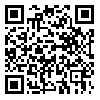Volume 11, Issue 2 (2023)
CLRJ 2023, 11(2): 89-118 |
Back to browse issues page
Download citation:
BibTeX | RIS | EndNote | Medlars | ProCite | Reference Manager | RefWorks
Send citation to:



BibTeX | RIS | EndNote | Medlars | ProCite | Reference Manager | RefWorks
Send citation to:
Sadeghi Sahlabad Z. Representation of the image of the Iranian myth "Pery" in the poem "Div and Pery" by Andrey Podolinsky. CLRJ 2023; 11 (2) :89-118
URL: http://clrj.modares.ac.ir/article-12-71670-en.html
URL: http://clrj.modares.ac.ir/article-12-71670-en.html
Associate Professor, Department of Russian Language, Faculty of Literature, Alzahra University, Tehran, Iran. , z.sadeghi@alzahra.ac.ir
Abstract: (1976 Views)
The present study examines the image of the Pery; It is dedicated as an Iranian myth in the poem of Andrey Podolinsky (1806-1886). Paying attention to this archetype is explained by the universal nature of this Iranian myth, which reveals a wide range of cultural meanings and carries a global meaning. This goes back to the existence of fairy images in Russian literary works at different times. The image of a fairy in the poem Demon and Pery by Podolinsky is borrowed from Iranian myths: Pery is a beautiful winged creature that lives in heaven. When he descends to the earth, he mourns the separation of the abandoned homeland and carries the idea of true repentance as salvation and return to heaven. The image of the demon is formed in opposition to the image of the Pery. The origin of the formation of the image of a Pery in Russian literature goes back to the poetic translation of the oriental story Lalla Rookh by the Irish poet Thomas Moore, which was done by Vasily Zhukovsky. Despite the fact that Zhukovsky's translation was a free translation, he introduced the theme of "The Pery Driven Out of Paradise" to Russian literature.
Article Type: Original Research |
Subject:
Adaptive Literature and Cultural Studies
Received: 2023/09/22 | Accepted: 2023/12/12 | Published: 2023/07/1
Received: 2023/09/22 | Accepted: 2023/12/12 | Published: 2023/07/1
Send email to the article author
| Rights and permissions | |
 |
This work is licensed under a Creative Commons Attribution-NonCommercial 4.0 International License. |







